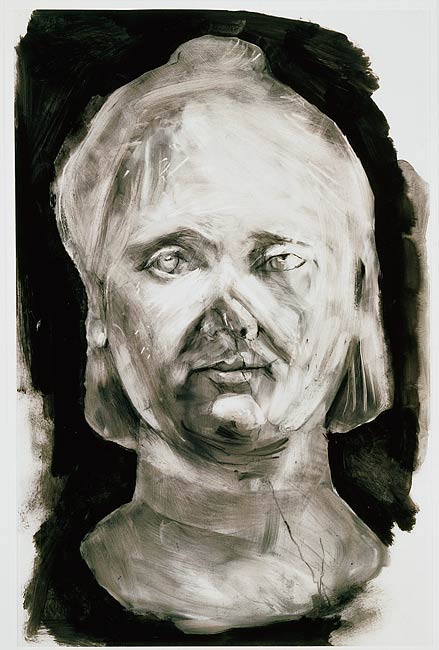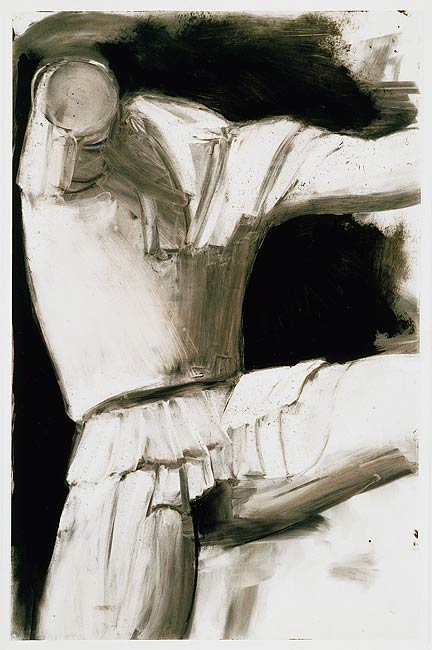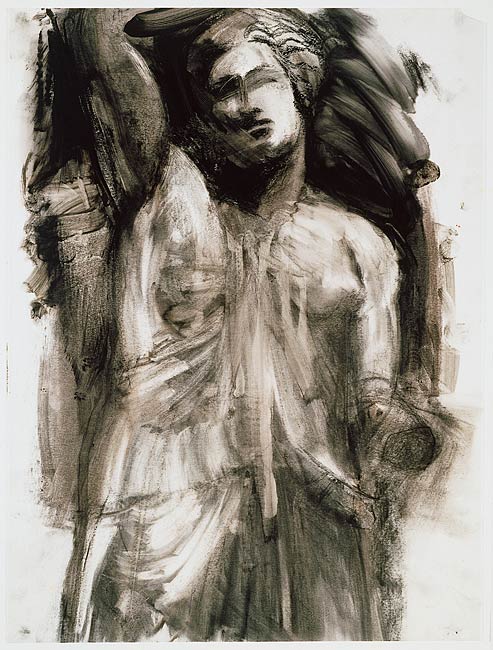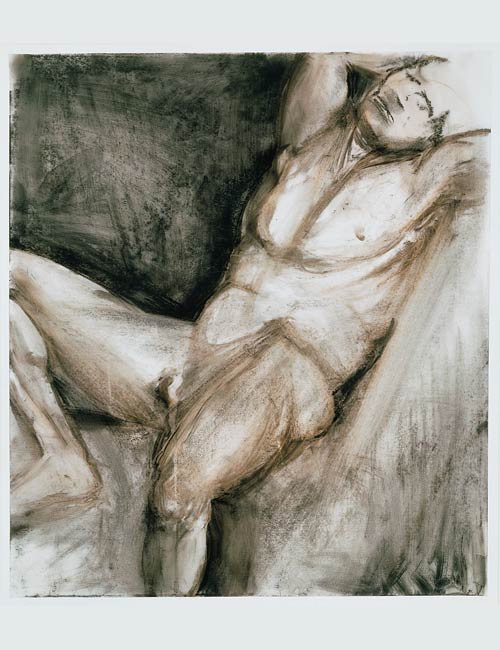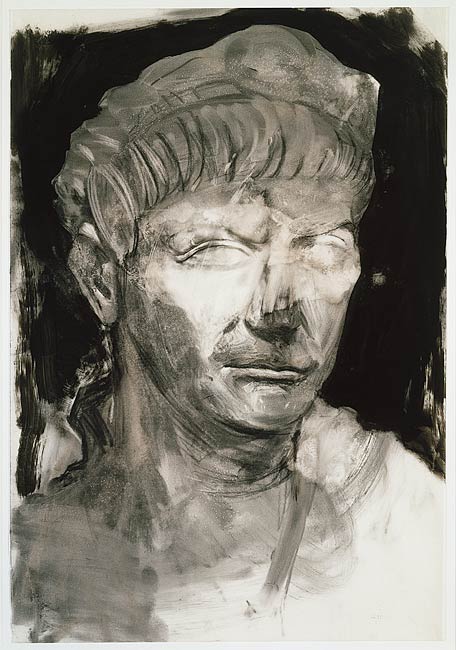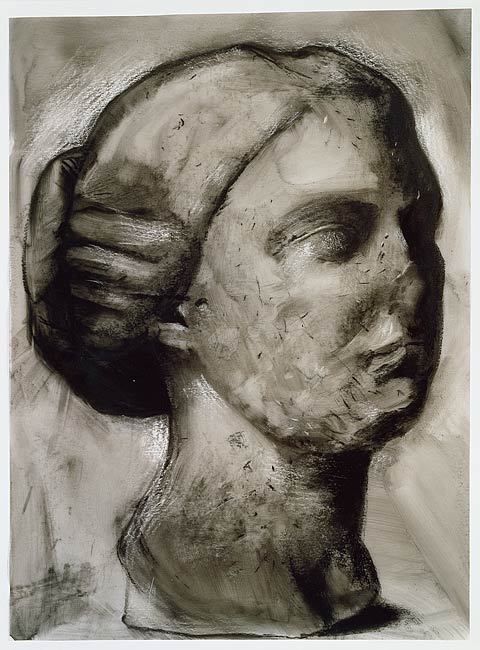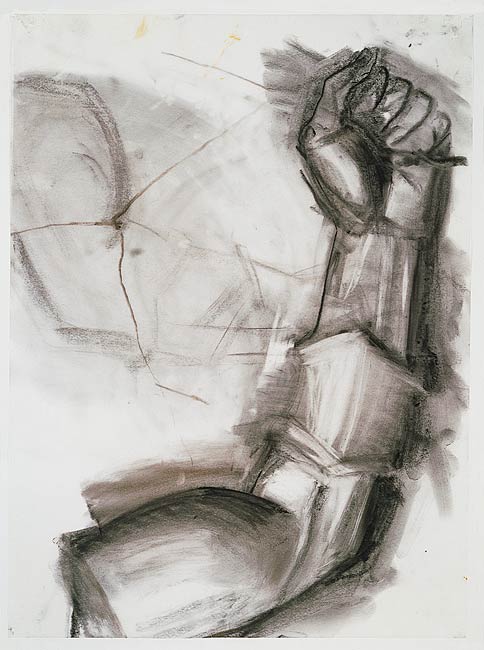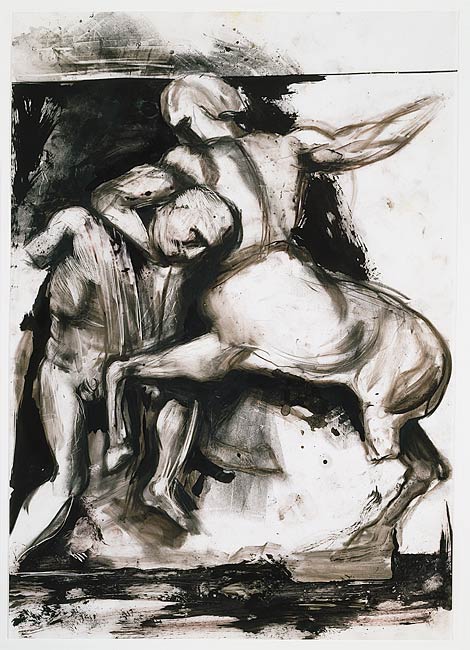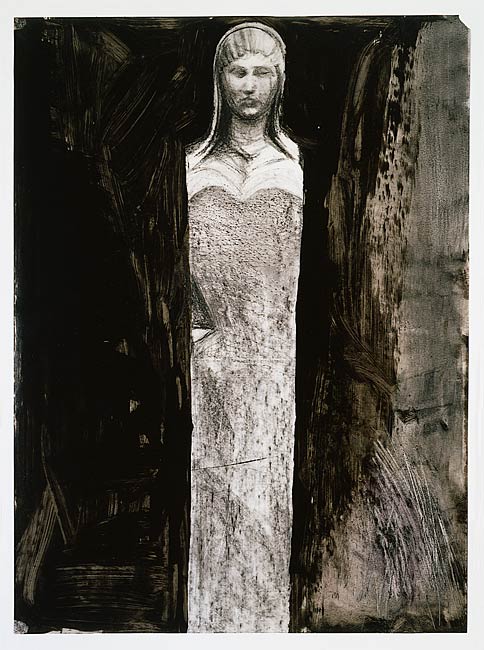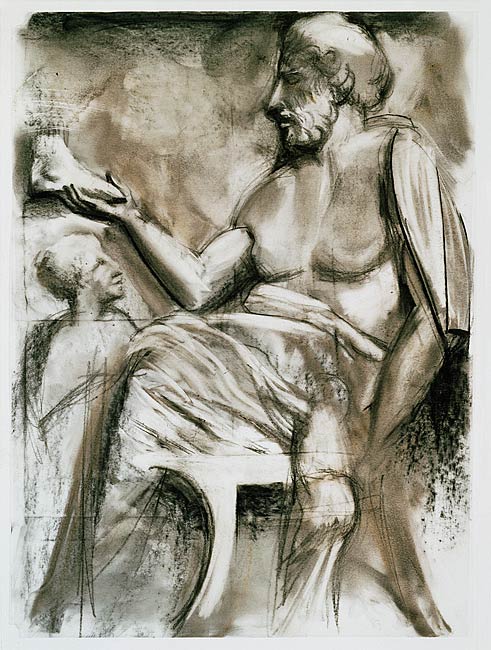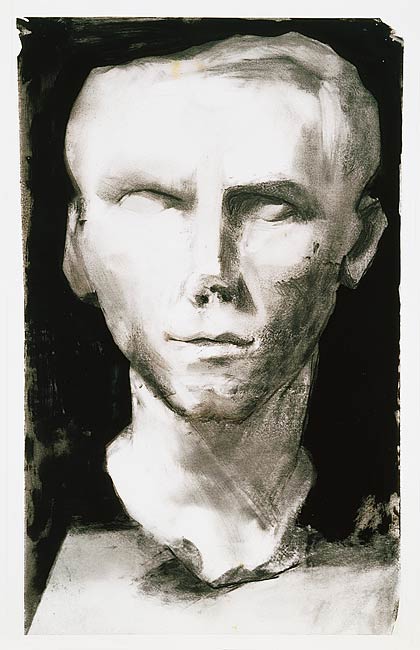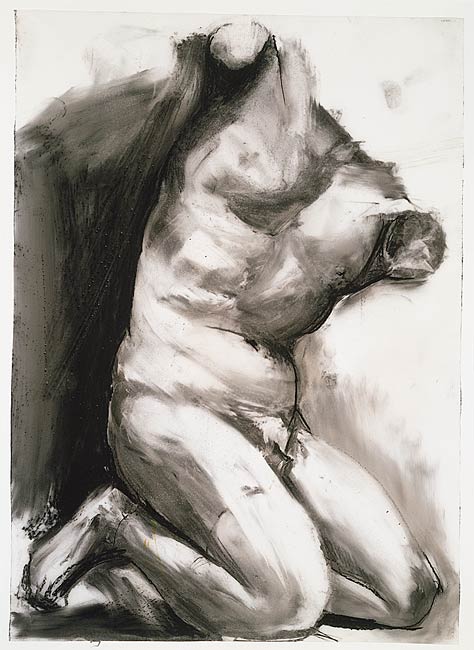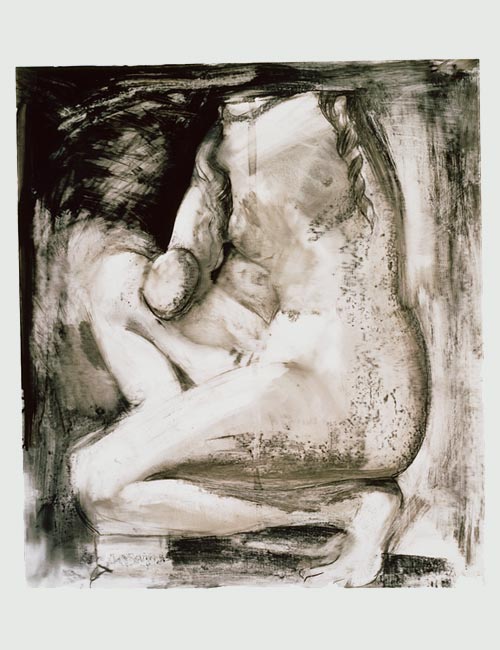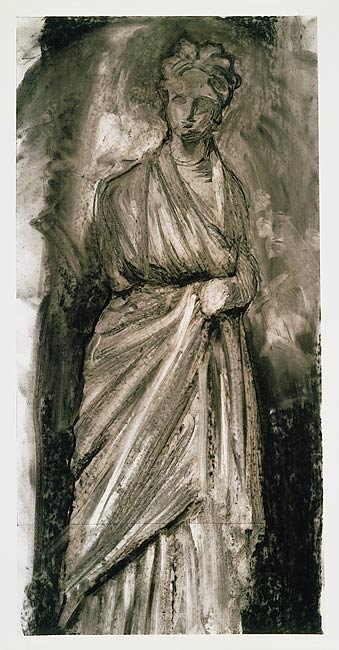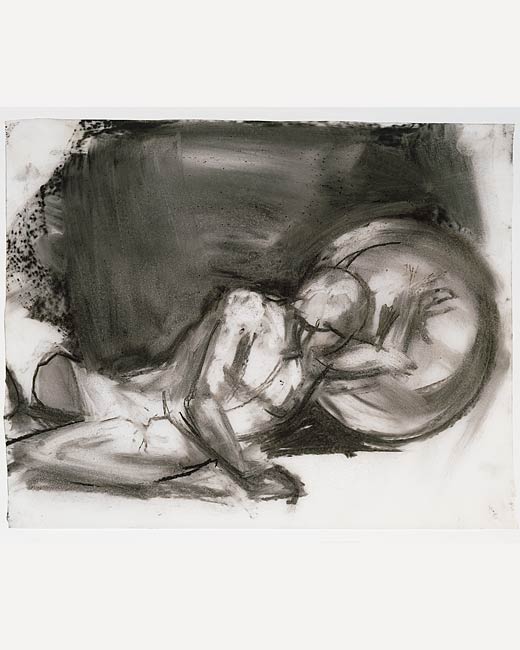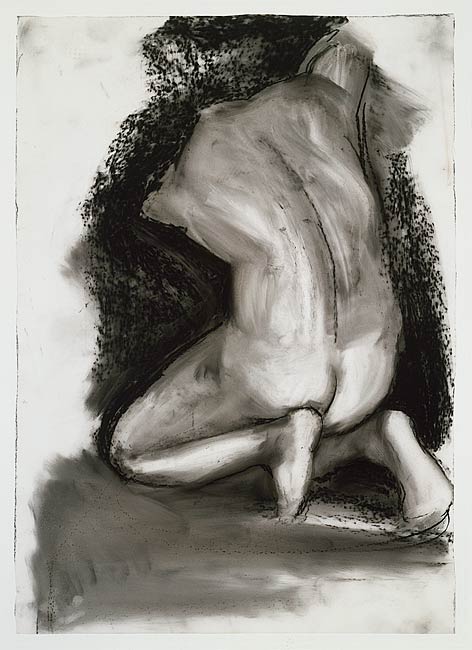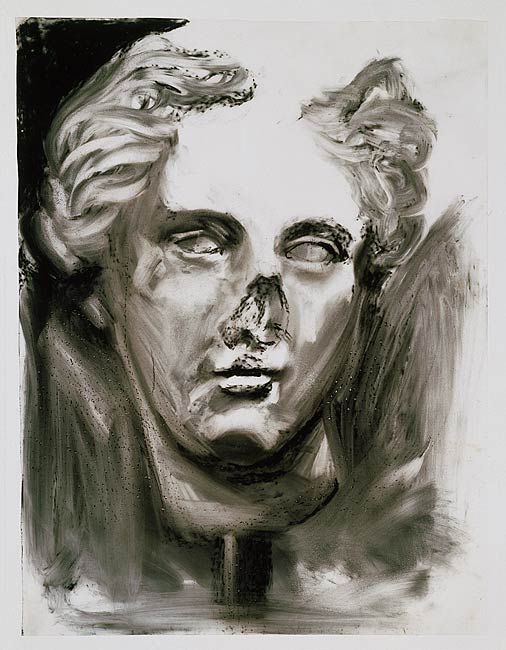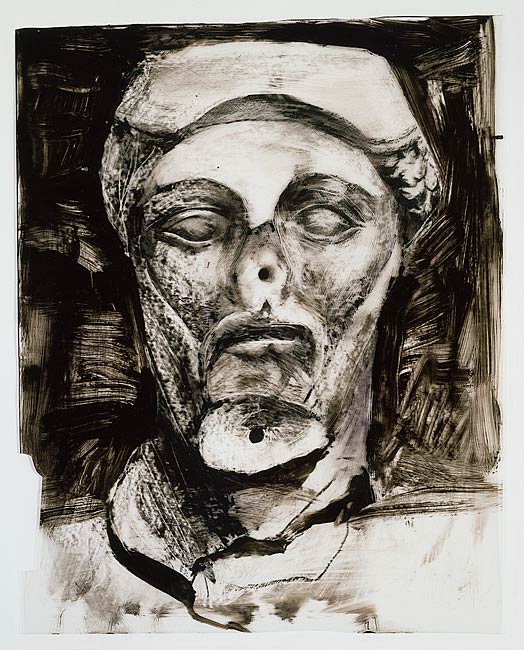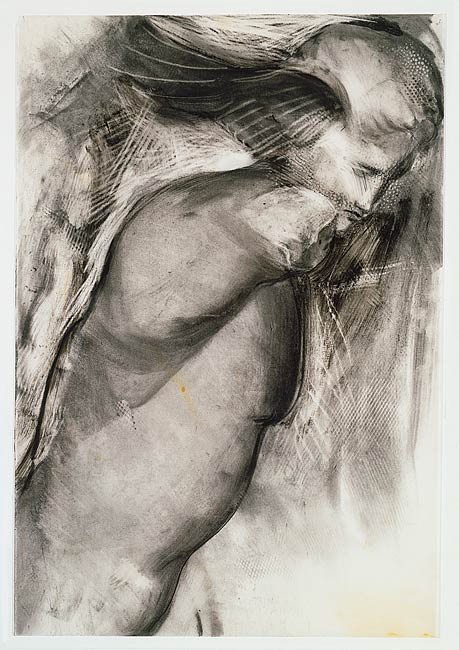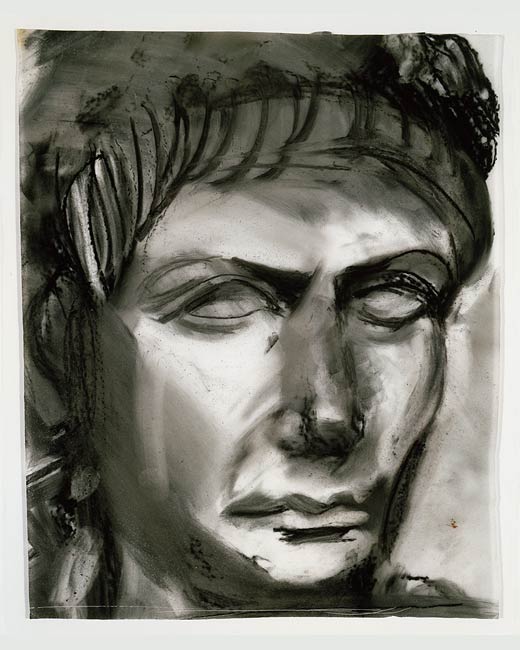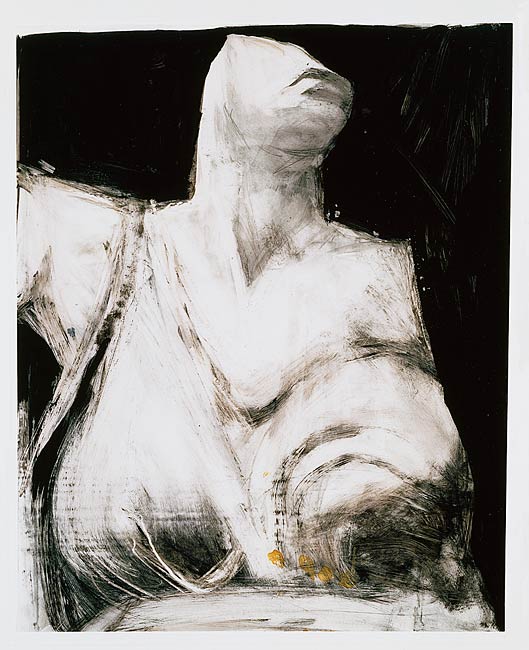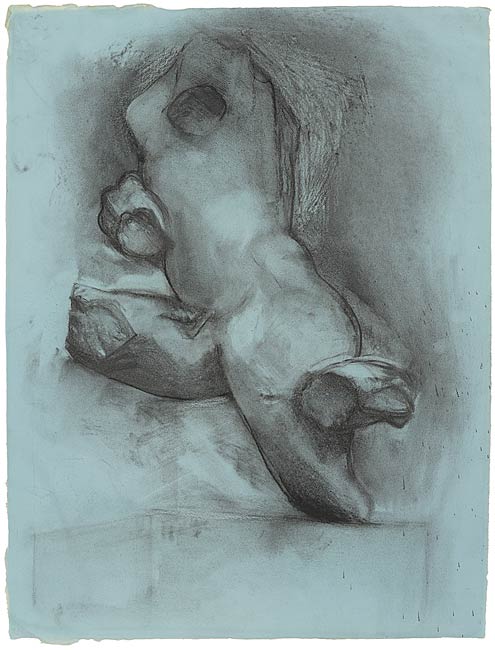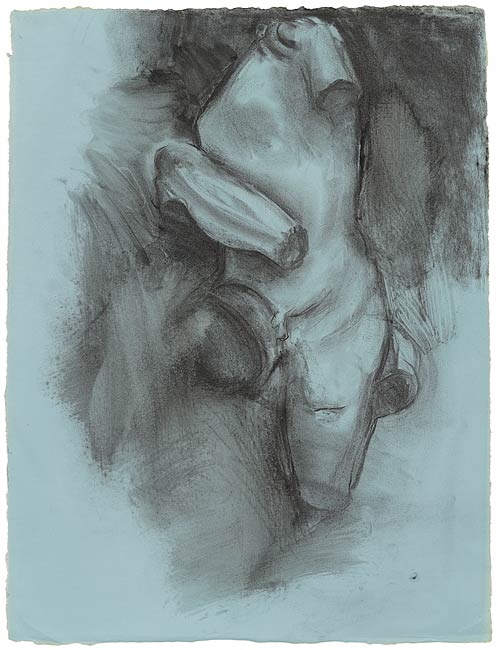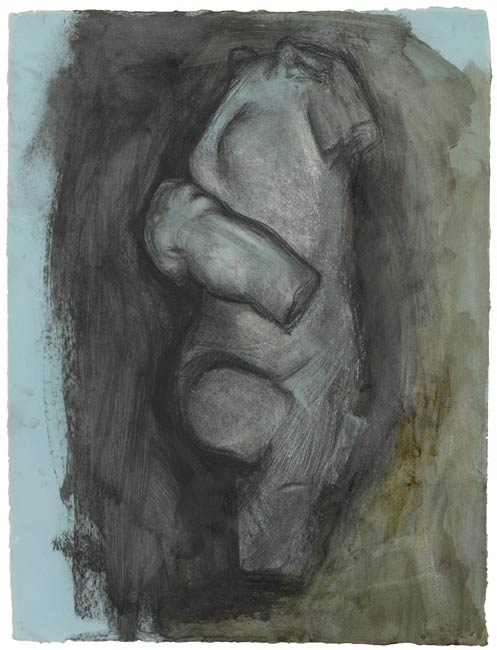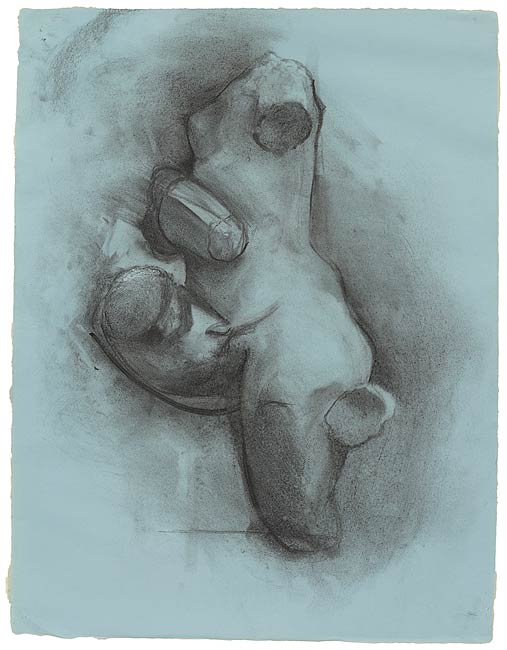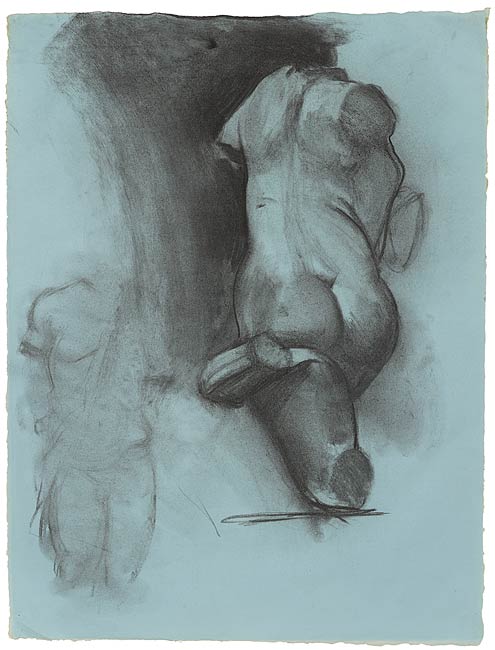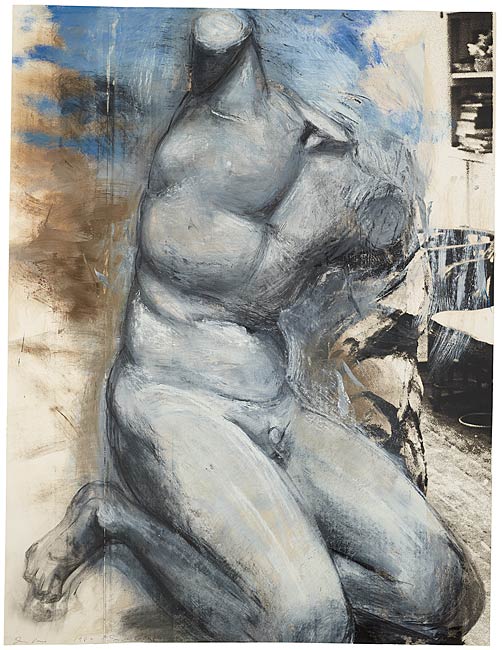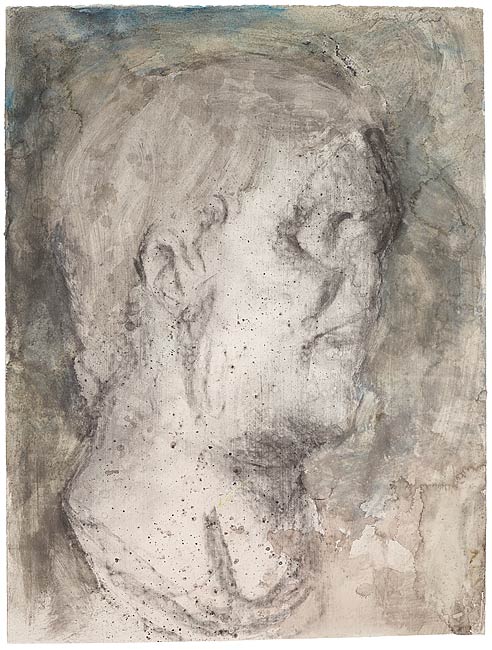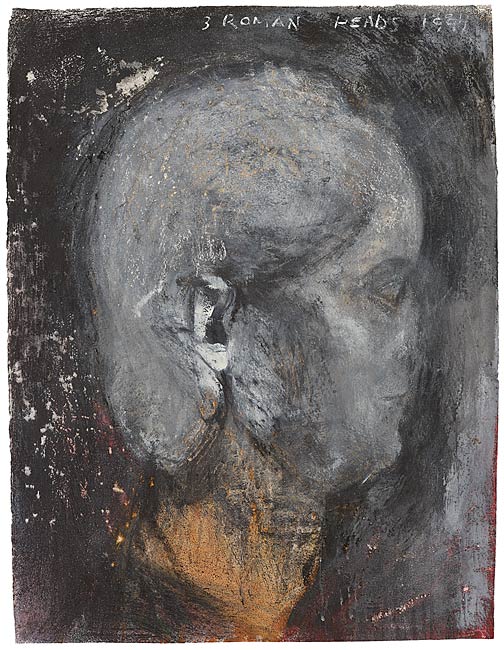Glyptotek Drawings
Glyptotek Drawings [1]
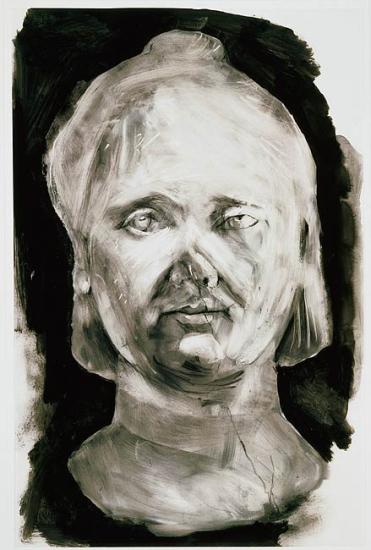
Glyptotek Drawings [1]
Photograph courtesy of The Pace Gallery.
© 2011 Jim Dine / Artists Rights Society (ARS), New York
Glyptotek Drawings [2]
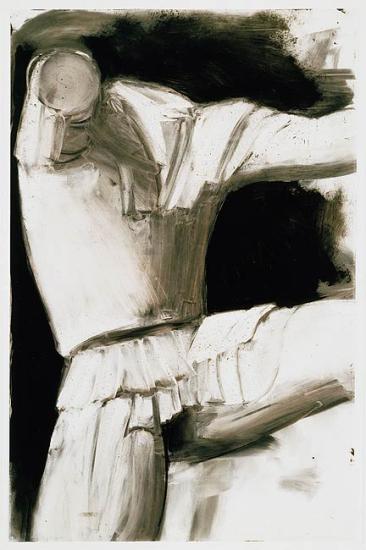
Glyptotek Drawings [2]
Here Dine is interested in the fragmentary quality of antique sculpture. Although the figure is centrally placed within the sheet, its jutting limbs make the composition explode into the viewer's space. By cropping the figure, Dine heightened the fragmentary nature of these objects.
Photograph courtesy of The Pace Gallery.
© 2011 Jim Dine / Artists Rights Society (ARS), New York
Glyptotek Drawings [3]
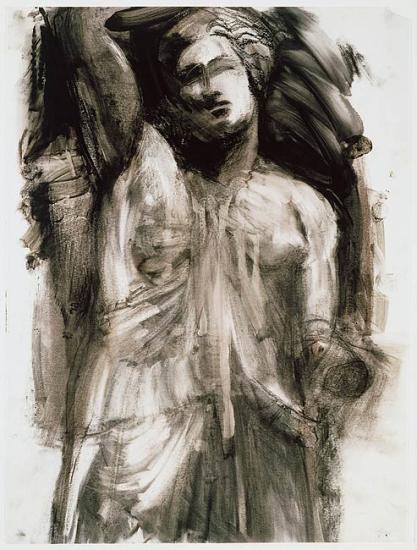
Glyptotek Drawings [3]
Dine's enthusiasm for materials and process is evident in the large, inky fingerprints (near the swaths of charcoal in the upper right corner) and in the abraded surface. He sanded the sheet with an emery board and picked at it with an etching-plate scraper and razor blade "to put more light into the drawing."
Photograph courtesy of The Pace Gallery.
© 2011 Jim Dine / Artists Rights Society (ARS), New York
Glyptotek Drawings [4]
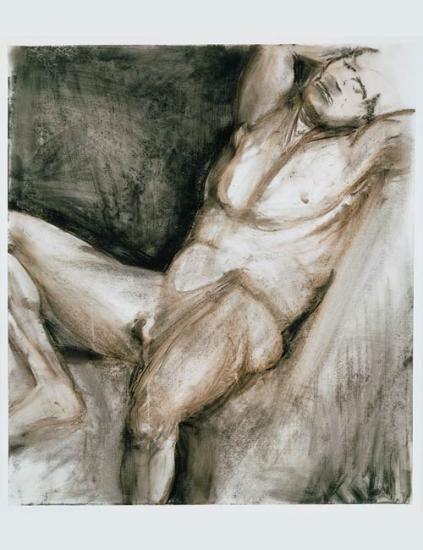
Glyptotek Drawings [1]
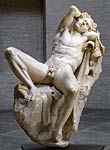 One of the most celebrated sculptures from antiquity, the Barberini Faun depicts a drunken, sleeping satyr, sprawled on a rock. In this sheet, Dine emphasized the satyr's dreamlike state and heightened the sculpture's sensual abandon with light washes that soften the rocky bed.
One of the most celebrated sculptures from antiquity, the Barberini Faun depicts a drunken, sleeping satyr, sprawled on a rock. In this sheet, Dine emphasized the satyr's dreamlike state and heightened the sculpture's sensual abandon with light washes that soften the rocky bed.
Barberini Faun, ca. 220 B.C.., Glyptothek, Munich
Staatliche Antikensammlungen und Glyprothek München
Photograph by : Renate Kühling
Photograph courtesy of The Pace Gallery.
© 2011 Jim Dine / Artists Rights Society (ARS), New York
Glyptotek Drawings [5]
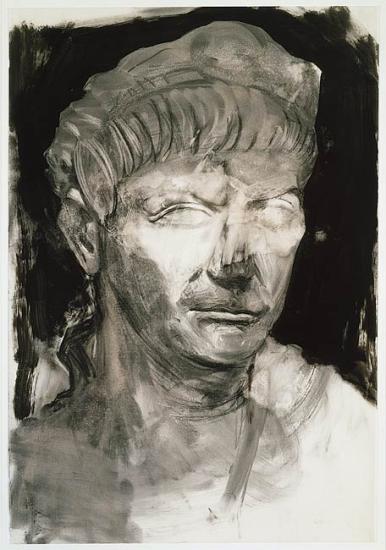
Glyptotek Drawings [5]
Photograph courtesy of The Pace Gallery.
© 2011 Jim Dine / Artists Rights Society (ARS), New York
Glyptotek Drawings [6]
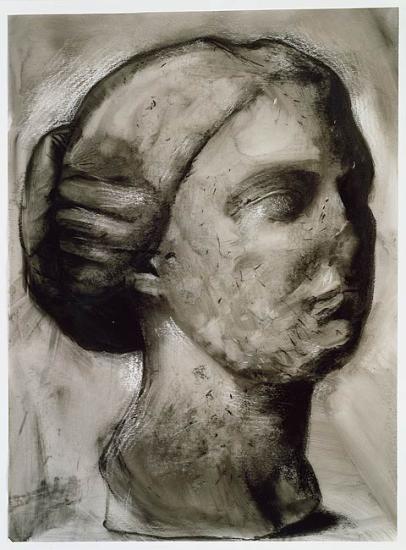
Glyptotek Drawings [6]
Of his process, Dine has said: "In a drawing, I dig into the paper with marks for the ultimate emotional impact." For all the Glyptotek Drawings, Dine chose to work solely with black media. The white patches highlighting the figure at her nape, forehead, and behind her hair are the result of the artist abrading the surface with a knife or scraper.
Photograph courtesy of The Pace Gallery.
© 2011 Jim Dine / Artists Rights Society (ARS), New York
Glyptotek Drawings [7]
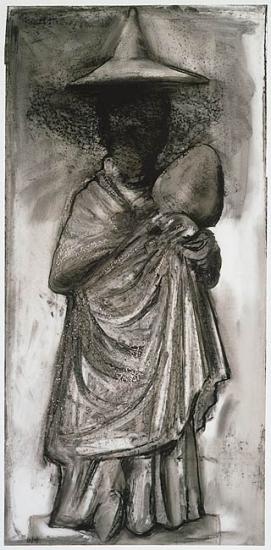
Glyptotek Drawings [7]
While the majority of the Glyptotek Drawings were inspired by antique marbles, this is one of two based on terra-cotta Tanagra figurines. Named after the site in central Greece where thousands of such figures were unearthed, these small sculptures depict draped women, often wearing hats and holding fans.
To produce the veil-like haze that obscures the figure's face, Dine used the frottage technique: he placed a rough surface underneath the plastic sheet and rubbed the drawing with a compressed charcoal crayon. "My work is based on the physical," he said. "The act of making this stuff is not contemplative. Nor is it what would be called conceptual."
Photograph courtesy of The Pace Gallery.
© 2011 Jim Dine / Artists Rights Society (ARS), New York
Glyptotek Drawings [8]
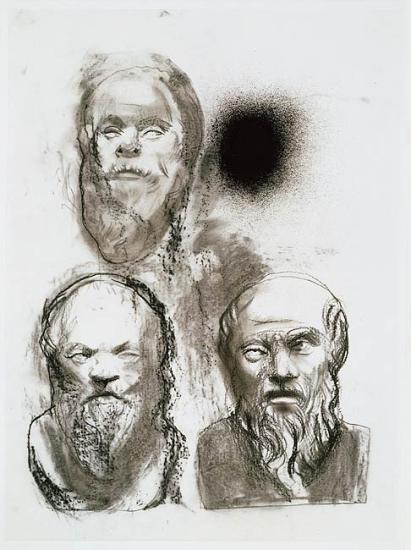
Glyptotek Drawings [8]
Dine drew these three studies of the head of Socrates, the fourth- century B.C.. philosopher, from the same frontal viewpoint, but he worked them to various degrees. Dine directly applied spray enamel onto the sheet, creating a burst of rich black in the top right corner.
Photograph courtesy of The Pace Gallery.
© 2011 Jim Dine / Artists Rights Society (ARS), New York
Glyptotek Drawings [9]
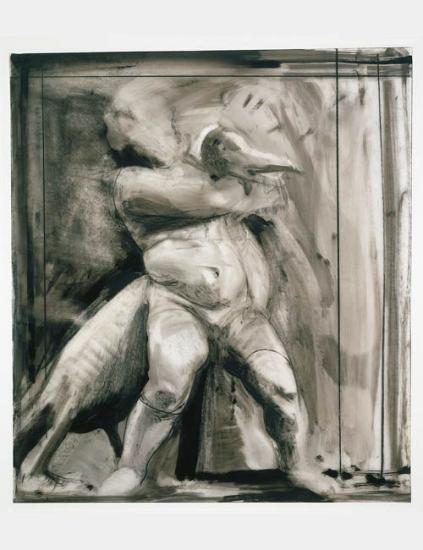
Glyptotek Drawings [9]
The sculpture depicts a young child playfully struggling with a goose, a popular subject in antiquity. Dine intensified the goose's struggle with three strokes that seem to emanate from the bird's head, recall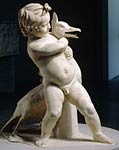 ing the expressive shorthand for exertion often found in comic books and cartoons.
ing the expressive shorthand for exertion often found in comic books and cartoons.
Dine's consideration of the printing process is evident in this sheet. The nearly square drawing was larger than the printing plate. The ruled lines framing the figure mark the limits of the printed image. In the Glyptotek book, the back leg and tail of the goose is cut off.
Boy with a Goose, ca. 250–200 B.C.., Glyptothek, Munich
Staatliche Antikensammlungen und Glyprothek München
Photograph by : Renate Kühling
Photograph courtesy of The Pace Gallery.
© 2011 Jim Dine / Artists Rights Society (ARS), New York
Glyptotek Drawings [10]
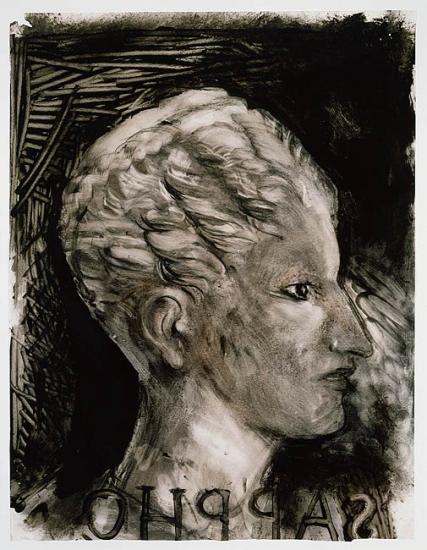
Glyptotek Drawings [10]
Dine's conception of the Glyptotek project began with a literary reference: "I knew from the start I wanted to include Sappho." This drawing of the seventh-century-B.C.. poet is one of the earliest in the series. The sheet is more heavily worked and detailed, especially around the eyes and in the profile. As the series progressed, Dine abandoned this approach and his marks became more gestural.
This is the only sheet in the series that includes text, which appears backward owing to the printing process. The composition is reversed on both the drawing and the printing plate; the inked printing plate transfers the image to the final sheet and inverts it.
Photograph courtesy of The Pace Gallery.
© 2011 Jim Dine / Artists Rights Society (ARS), New York
Glyptotek Drawings [11]
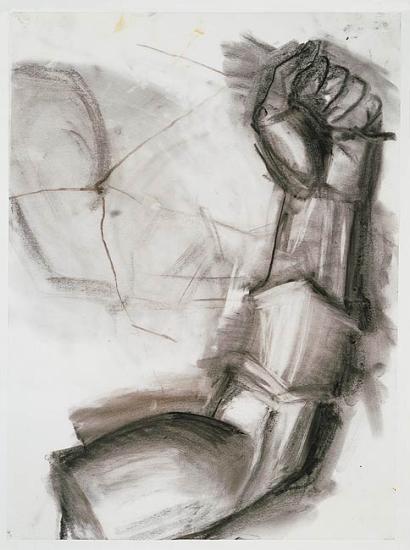
Glyptotek Drawings [11]
In creating the Glyptotek drawings, Dine was drawn to the sculptures' imperfections: "I like to honor any accident or destruction of the marks that will enhance a new beginning." The chipped noses, broken limbs, and irregular surfaces reveal the passage of time, yet their fragmentary nature also speaks to a very modern aesthetic. This is evident in the flat, unmoored quality of the soldier's arm. In reality, the unspecified background space is the back of the soldier's shield. Dine has further altered the subject's orientation, rotating the fallen warrior's arm from a horizontal to a vertical position.
Photograph courtesy of The Pace Gallery.
© 2011 Jim Dine / Artists Rights Society (ARS), New York
Glyptotek Drawings [12]
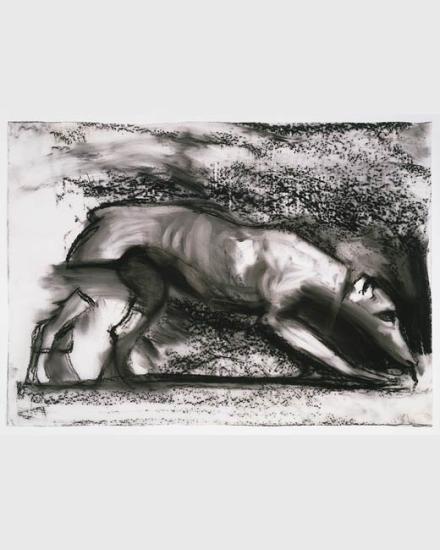
Glyptotek Drawings [12]
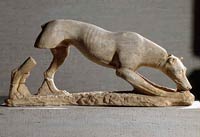 In Ancient Greece, graves were marked with stelae ornamented with relief depictions of the deceased and their attributes. This hunting hound originally marked a grave site. The dog is depicted in mourning, with its head down and nose to the ground.
In Ancient Greece, graves were marked with stelae ornamented with relief depictions of the deceased and their attributes. This hunting hound originally marked a grave site. The dog is depicted in mourning, with its head down and nose to the ground.
Hunting Hound, ca. 350 B.C.., Glyptothek, Munich
Staatliche Antikensammlungen und Glyprothek München
Photograph by : Renate Kühling
Photograph courtesy of The Pace Gallery.
© 2011 Jim Dine / Artists Rights Society (ARS), New York
Glyptotek Drawings [13]

Glyptotek Drawings [13]
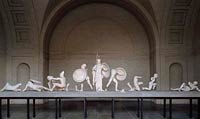 The wounded soldier depicted here comes from the west pediment of the Temple of Aphaia in Aegina (ca. 485–480 B.C..). The triangular frame of the pediment (the space formed by the pitch of the roof) determined the composition of the sculptural program, which represents a battle between Greeks and Trojans. The fallen warrior, lying on his side, is situated at the far right corner of the architectural element.
The wounded soldier depicted here comes from the west pediment of the Temple of Aphaia in Aegina (ca. 485–480 B.C..). The triangular frame of the pediment (the space formed by the pitch of the roof) determined the composition of the sculptural program, which represents a battle between Greeks and Trojans. The fallen warrior, lying on his side, is situated at the far right corner of the architectural element.
West Pediment, Temple of Aphaia, Aegina, Glyptothek, Munich
Staatliche Antikensammlungen und Glyprothek München
Photograph by : Renate Kühling
Photograph courtesy of The Pace Gallery.
© 2011 Jim Dine / Artists Rights Society (ARS), New York
Glyptotek Drawings [14]
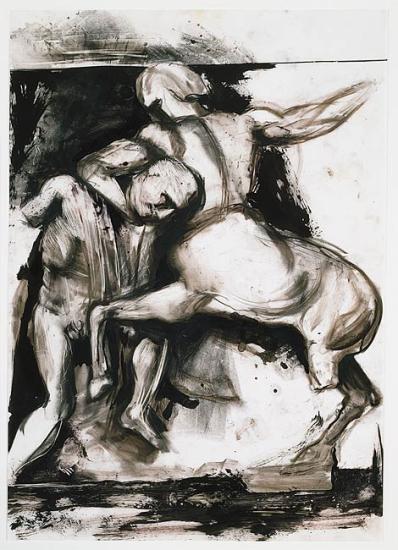
Glyptotek Drawings [14]
Photograph courtesy of The Pace Gallery.
© 2011 Jim Dine / Artists Rights Society (ARS), New York
Glyptotek Drawings [15]

Glyptotek Drawings [15]
Photograph courtesy of The Pace Gallery.
© 2011 Jim Dine / Artists Rights Society (ARS), New York
Glyptotek Drawings [16]
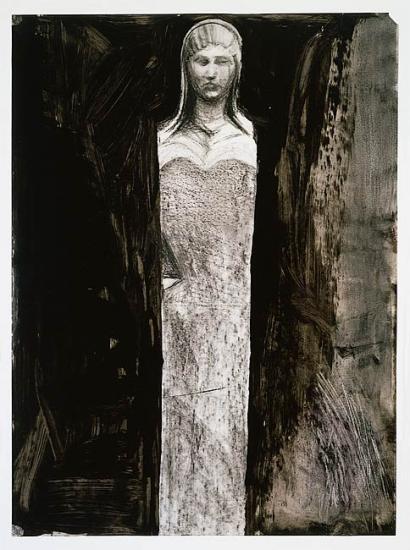
Glyptotek Drawings [16]
Photograph courtesy of The Pace Gallery.
© 2011 Jim Dine / Artists Rights Society (ARS), New York
Glyptotek Drawings [17]
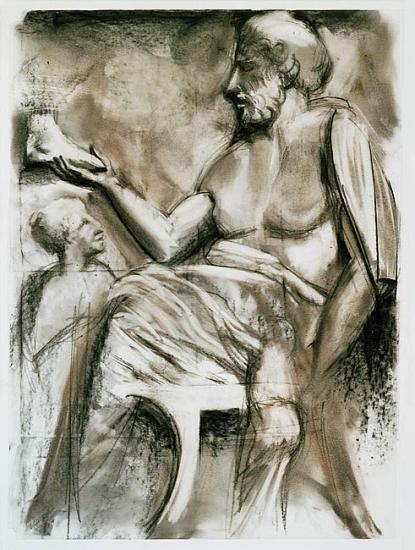
Glyptotek Drawings [17]
In creating his own Glyptotek, Dine recalled, "I built it from photos and postcards and books on the ancient world." This drawing was inspired by the marble gravestone of Xanthippos, now in the British Museum, London.
In ancient Greece, graves were marked with stelae ornamented with relief depictions of the deceased. This relief represented a shoemaker framed within an architectural setting. Dine did away with any sense of an architectural space, thereby enhancing the figure's immediacy.
Photograph courtesy of The Pace Gallery.
© 2011 Jim Dine / Artists Rights Society (ARS), New York
Glyptotek Drawings [18]
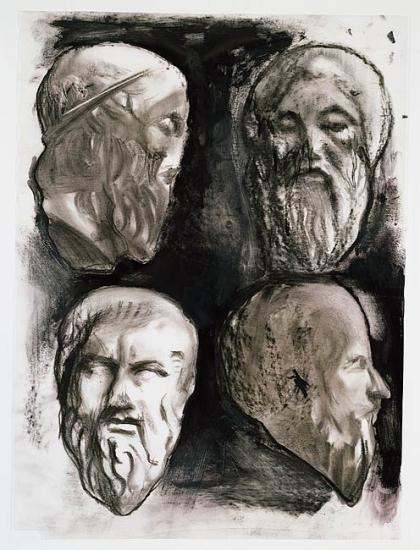
Glyptotek Drawings [18]
This sheet presents a frontal and profile view of Homer at the top and one of Plato at the bottom. Homer, the eighth-century-B.C.. blind poet credited with the Iliad and the Odyssey, is identifiable by his lidded eyes. Like Homer, the Athenian philosopher Plato (429–347 B.C..) is depicted with his mouth slightly agape. The disembodied heads appear removed from the everyday world, lost in contemplative tranquility.
Photograph courtesy of The Pace Gallery.
© 2011 Jim Dine / Artists Rights Society (ARS), New York
Glyptotek Drawings [19]
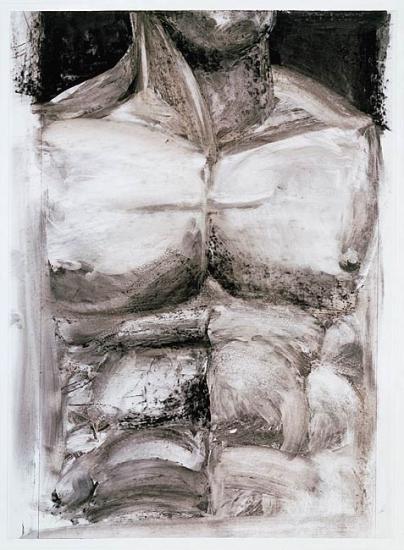
Glyptotek Drawings [19]
Photograph courtesy of The Pace Gallery.
© 2011 Jim Dine / Artists Rights Society (ARS), New York
Glyptotek Drawings [20]
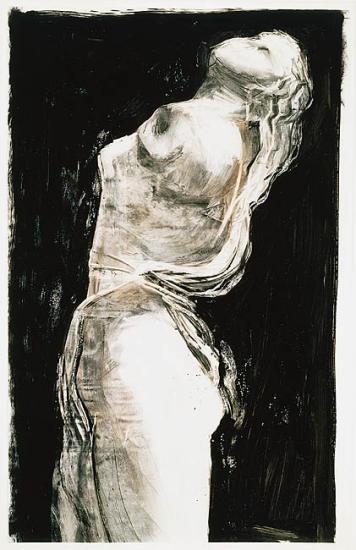
Glyptotek Drawings [20]
In 1979 Dine said, "I'm looking more at ancient art now, because I'm trying to understand sculpture." In the present work, Dine stressed the dialogue between sculpture and drawing by scratching into the drawing's surface. This subtractive process is particularly evident in the drapery folds that define the figure.
This drawing was inspired by a sculpture commonly referred to as the Dresden Maenad, in the collection of the Skulpturensammlung Staatliche Kunstsammlungen, Dresden, Germany. A term for a female follower of Dionysus, the Greek god of wine, Maenads are often depicted dancing or in a state of divine frenzy. This drawing is remarkable for its dramatic perspective and sense of movement, established by the low point of view and the figure twisting towards us.
Photograph courtesy of The Pace Gallery.
© 2011 Jim Dine / Artists Rights Society (ARS), New York
Glyptotek Drawings [21]
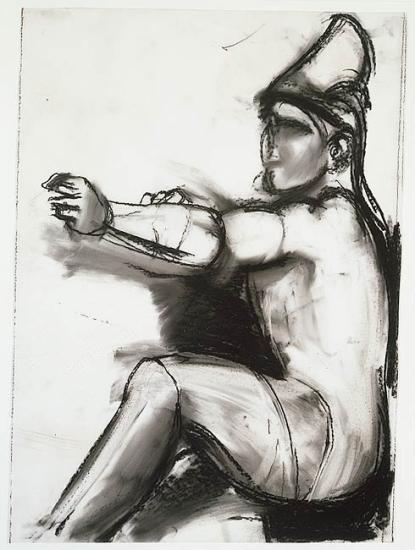
Glyptotek Drawings [21]
In choosing his sculptural sources, Dine was drawn to single-figure compositions and rarely chose multi-figure groups. He extracted the subject of this drawing, an archer sometimes identified as Paris, Prince of Troy, from the west pediment of the Temple of Aphaia in Aegina (ca. 485–480 BC). Reconstructed at the Glyptothek, Munich, the pediment’s sculptural program depicts the Trojan War and features several figures interacting in battle. Dine chose to omit the overlapping figures in favor of a more concentrated study of the archer.
Photograph courtesy of The Pace Gallery.
© 2011 Jim Dine / Artists Rights Society (ARS), New York
Glyptotek Drawings [22]
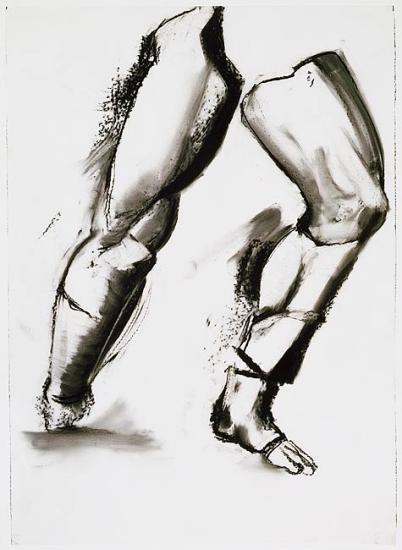
Glyptotek Drawings [22]
Photograph courtesy of The Pace Gallery.
© 2011 Jim Dine / Artists Rights Society (ARS), New York
Glyptotek Drawings [23]
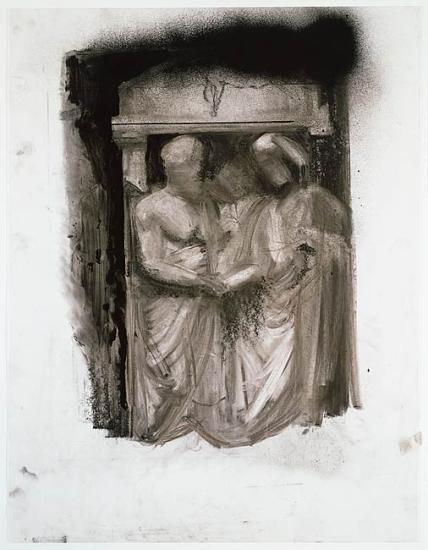
Glyptotek Drawings [23]
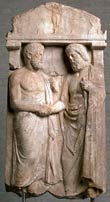 This sheet combines a rich variety of media—india ink, charcoal, and spray paint. In keeping with the fragmented base of the Grave Stele of Artemon, Dine left the lower half of the sheet empty. In contrast, the top is heavily worked and marked by a direct application of spray paint.
This sheet combines a rich variety of media—india ink, charcoal, and spray paint. In keeping with the fragmented base of the Grave Stele of Artemon, Dine left the lower half of the sheet empty. In contrast, the top is heavily worked and marked by a direct application of spray paint.
Grave Stele of Artemon, ca. 350 B.C.., Glyptothek, Munich
Staatliche Antikensammlungen und Glyprothek München
Photograph by : Renate Kühling
Photograph courtesy of The Pace Gallery.
© 2011 Jim Dine / Artists Rights Society (ARS), New York
Glyptotek Drawings [24]
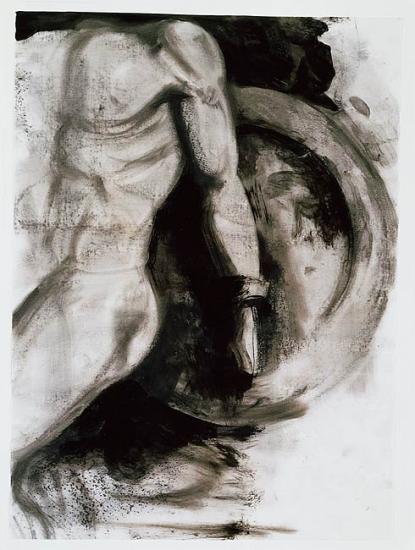
Glyptotek Drawings [24]
Photograph courtesy of The Pace Gallery.
© 2011 Jim Dine / Artists Rights Society (ARS), New York
Glyptotek Drawings [25]
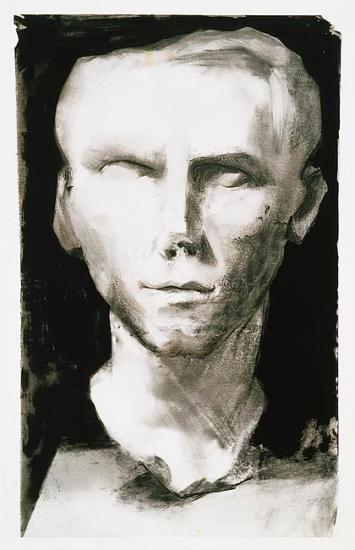
Glyptotek Drawings [25]
Photograph courtesy of The Pace Gallery.
© 2011 Jim Dine / Artists Rights Society (ARS), New York
Glyptotek Drawings [26]
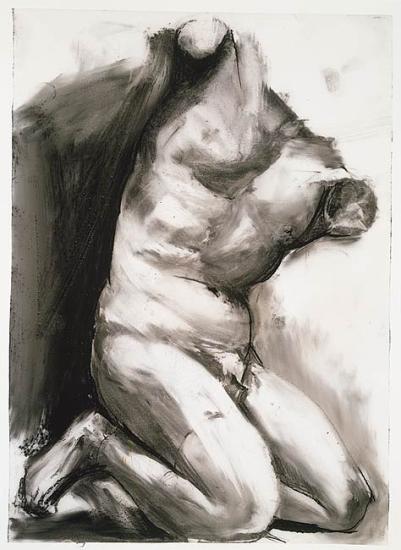
Glyptotek Drawings [26]
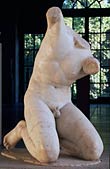 This is one of two drawings inspired by a sculpture of a kneeling youth protecting himself from an impending attack. It is the only figure Dine repeated throughout the forty Glyptotek Drawings. He revisited the figure in the drawing Twisted Torso of A Youth (Ilioneus, ca. 300 BC), 1989, also on view in the exhibition.
This is one of two drawings inspired by a sculpture of a kneeling youth protecting himself from an impending attack. It is the only figure Dine repeated throughout the forty Glyptotek Drawings. He revisited the figure in the drawing Twisted Torso of A Youth (Ilioneus, ca. 300 BC), 1989, also on view in the exhibition.
Torso of a Kneeling Athlete, ca. 300 B.C.., Glyptothek, Munich
Staatliche Antikensammlungen und Glyprothek München
Photograph by : Renate Kühling
Photograph courtesy of The Pace Gallery.
© 2011 Jim Dine / Artists Rights Society (ARS), New York
Glyptotek Drawings [27]
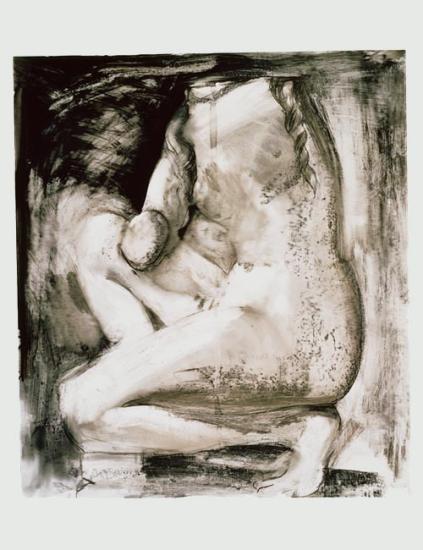
Glyptotek Drawings [27]
Dine chose to work on translucent paper and plastic sheets to give the drawings "some sense of light." These unconventional supports allowed for little absorption and afforded the artist a great degree of creative play. He manipulated the unfixed materials with a variety of tools—from erasers and knives to his own fingers. Here, Dine's incorporation of random effects can be seen in the line of fixative that runs directly down the center of the sheet.
Photograph courtesy of The Pace Gallery.
© 2011 Jim Dine / Artists Rights Society (ARS), New York
Glyptotek Drawings [28]

Glyptotek Drawings [28]
While the majority of the Glyptotek Drawings were inspired by antique marbles, this is one of two drawings based on terra cotta Tanagra figurines. Named after the site in central Greece where thousands of such figures were unearthed, these small sculptures depict draped women, often wearing a hat and holding a fan.
Photograph courtesy of The Pace Gallery.
© 2011 Jim Dine / Artists Rights Society (ARS), New York
Glyptotek Drawings [29]
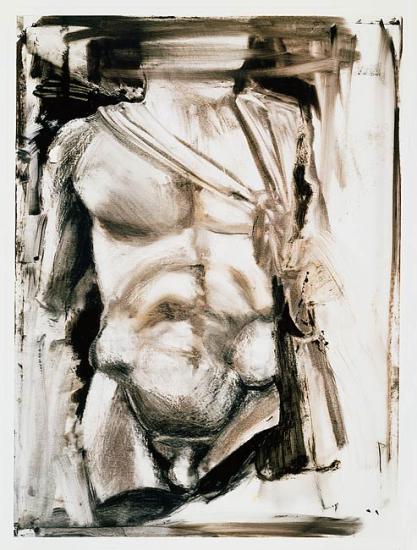
Glyptotek Drawings [29]
Photograph courtesy of The Pace Gallery.
© 2011 Jim Dine / Artists Rights Society (ARS), New York
Glyptotek Drawings [30]
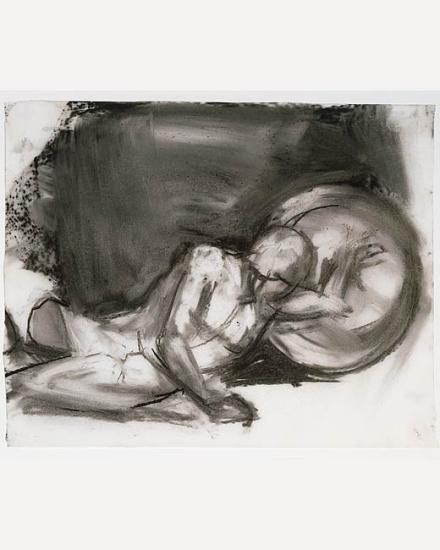
Glyptotek Drawings [30]
Photograph courtesy of The Pace Gallery.
© 2011 Jim Dine / Artists Rights Society (ARS), New York
Glyptotek Drawings [31]
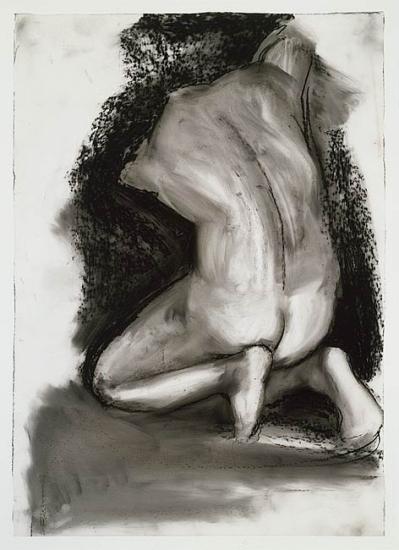
Glyptotek Drawings [31]
Here, Dine used an eraser not only to remove marks but also to manipulate the materials. For instance, the broad strokes of white along the figure's back result from wiping wet charcoal across the surface. The small specks are debris from Dine's eraser. Of these he commented: "I just left my tracks, as I often do."
Photograph courtesy of The Pace Gallery.
© 2011 Jim Dine / Artists Rights Society (ARS), New York
Glyptotek Drawings [32]
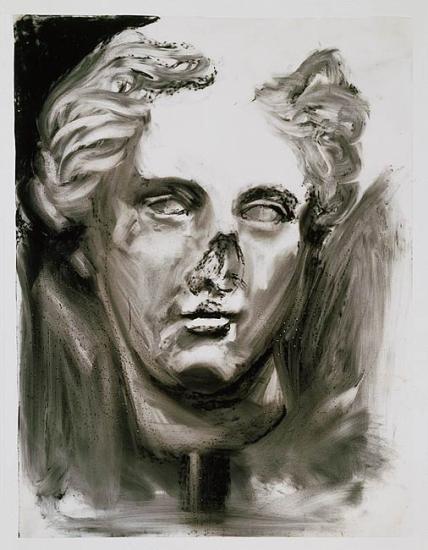
Glyptotek Drawings [32]
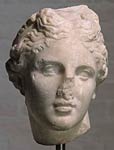 Dine's physical engagement with his materials is evident in the sensual treatment of Aphrodite's hair. He used his fingers to shape the charcoal, create highlights, and heighten the sense of movement.
Dine's physical engagement with his materials is evident in the sensual treatment of Aphrodite's hair. He used his fingers to shape the charcoal, create highlights, and heighten the sense of movement.
I choose things that I think can come alive. I don't want to draw these things as dead objects, as stone. I want to observe them carefully, and then I want to put life into them and make them vigorous and physical.
Head of Aphrodite, ca. 300 B.C.., Glyptothek, Munich
Staatliche Antikensammlungen und Glyprothek München
Photograph by : Renate Kühling
Photograph courtesy of The Pace Gallery.
© 2011 Jim Dine / Artists Rights Society (ARS), New York
Glyptotek Drawings [33]
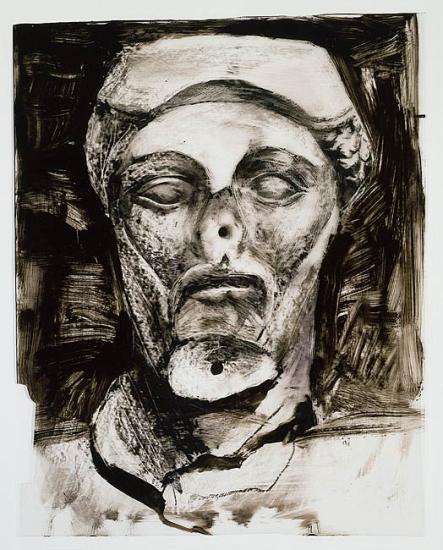
Glyptotek Drawings [33]
In 2004, Dine wrote: "A drawing is something you carve out of the paper rather than laying it on top. It is about the pressure, the physical pressure of exerting your hand with some sort of stylus... onto paper or canvas." This sheet, marked by rough passages and incisions, exemplifies Dine's conception of drawing as a physical process.
Photograph courtesy of The Pace Gallery.
© 2011 Jim Dine / Artists Rights Society (ARS), New York
Glyptotek Drawings [34]
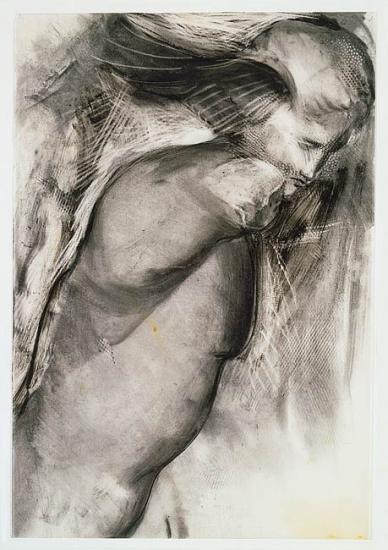
Glyptotek Drawings [34]
This drawing is characterized by a bold lattice-like pattern that Dine created with a wire mesh screen; first he used the screen to remove charcoal from the surface then transferred the charcoal by laying the screen down on another section of the sheet.
In making his "own Glyptothek" Dine referenced materials from other museum collections. This drawing was inspired by a statue of Hypnos, the personification of sleep, from the Museo del Prado, Madrid.
Photograph courtesy of The Pace Gallery.
© 2011 Jim Dine / Artists Rights Society (ARS), New York
Glyptotek Drawings [35]
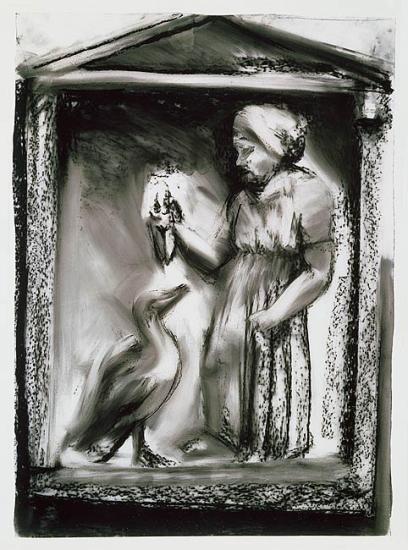
Glyptotek Drawings [35]
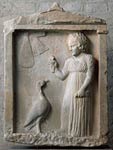 This grave stele depicts a young girl tenderly playing with a doll and goose. With his strong interplay of light and shadow as well as the contrast between sweeping strokes and rough surface textures, Dine imbued this image with romantic tone. It is a hauntingly modern vision of the ancient world.
This grave stele depicts a young girl tenderly playing with a doll and goose. With his strong interplay of light and shadow as well as the contrast between sweeping strokes and rough surface textures, Dine imbued this image with romantic tone. It is a hauntingly modern vision of the ancient world.
Grave Stele of a Girl with a Doll and a Goose, ca. 370–360 B.C.., Glyptothek, Munich
Staatliche Antikensammlungen und Glyprothek München
Photograph by : Renate Kühling
Photograph courtesy of The Pace Gallery.
© 2011 Jim Dine / Artists Rights Society (ARS), New York
Glyptotek Drawings [36]
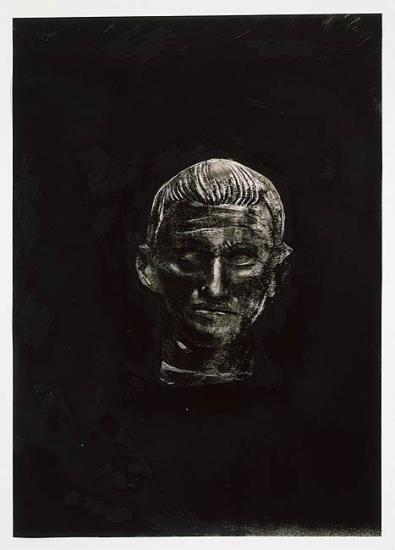
Glyptotek Drawings [36]
This drawing represents the lengths to which Dine searched for an opaque background, resulting in the print version in a rich, inky intaglio print devoid of white space. To create such a dense image, Dine first drew the portrait in charcoal and covered the entire background with spray paint. He then used a variety of media, including chalk, charcoal, and liquid varnish to fill in any translucent holes.
Photograph courtesy of The Pace Gallery.
© 2011 Jim Dine / Artists Rights Society (ARS), New York
Glyptotek Drawings [37]
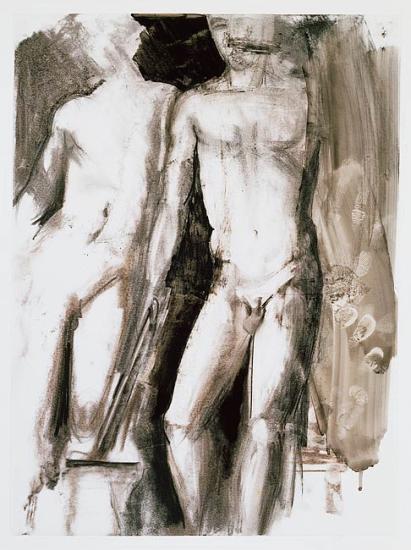
Glyptotek Drawings [37]
Photograph courtesy of The Pace Gallery.
© 2011 Jim Dine / Artists Rights Society (ARS), New York
Glyptotek Drawings [38]
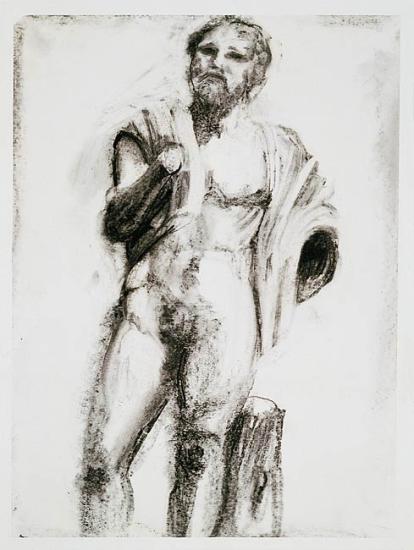
Glyptotek Drawings [38]
Photograph courtesy of The Pace Gallery.
© 2011 Jim Dine / Artists Rights Society (ARS), New York
Glyptotek Drawings [39]
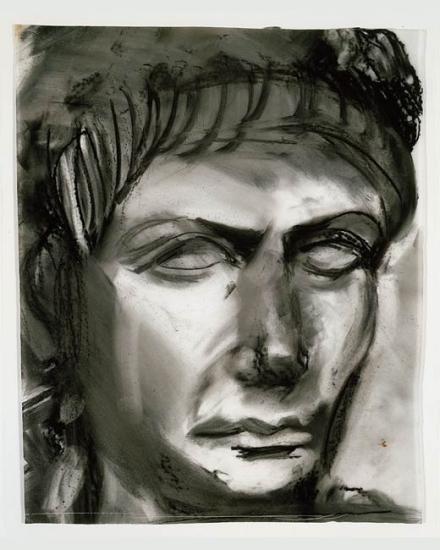
Glyptotek Drawings [39]
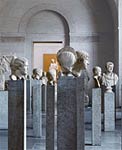 In the big hall of Roman portrait heads there must be over one hundred heads. You feel like you're in a crowd of people, but there is nothing heroic about it. It's very much on a human scale, right at the viewer's eye level.
In the big hall of Roman portrait heads there must be over one hundred heads. You feel like you're in a crowd of people, but there is nothing heroic about it. It's very much on a human scale, right at the viewer's eye level.
Hall of the Romans, Glyptothek, Munich
Staatliche Antikensammlungen und Glyprothek München
Photograph by : Renate Kühling
Photograph courtesy of The Pace Gallery.
© 2011 Jim Dine / Artists Rights Society (ARS), New York
Glyptotek Drawings [40]
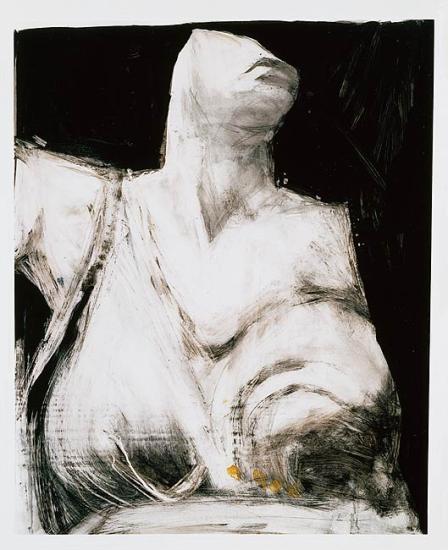
Glyptotek Drawings [40]
Photograph courtesy of The Pace Gallery.
© 2011 Jim Dine / Artists Rights Society (ARS), New York
Seven Views of the Hermaphrodite [1]
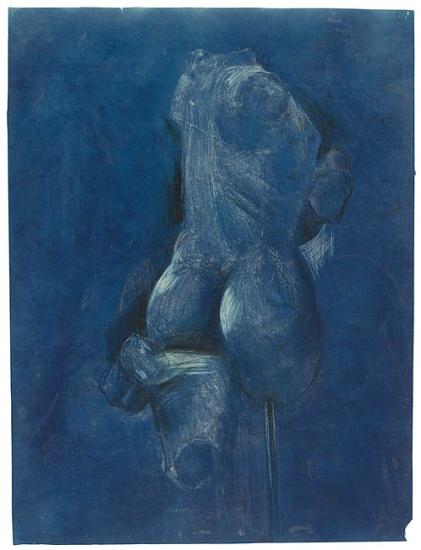
Seven Views of the Hermaphrodite [1]
In 1990 Dine traveled to the Ny Carlsberg Glyptotek in Copenhagen, where he spent seven days in the galleries to create this seven-part work, based on a statue of a hermaphrodite.
To highlight the subject's dual sexuality, antique sculptures of hermaphrodites typically display the figure in a complex, twisting pose. In each drawing, Dine depicted the figure from a different viewpoint. The sequence invokes the movement of the turning figure and its ability to define the space around it.
© 2011 Jim Dine / Artists Rights Society (ARS), New York
Seven Views of the Hermaphrodite [2]
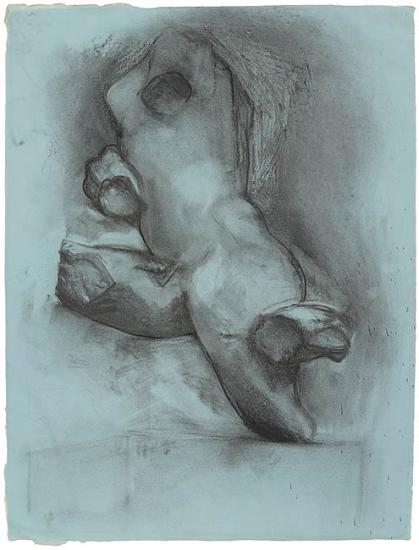
Seven Views of the Hermaphrodite [2]
In 1990 Dine traveled to the Ny Carlsberg Glyptotek in Copenhagen, where he spent seven days in the galleries to create this seven-part work, based on a statue of a hermaphrodite.
To highlight the subject's dual sexuality, antique sculptures of hermaphrodites typically display the figure in a complex, twisting pose. In each drawing, Dine depicted the figure from a different viewpoint. The sequence invokes the movement of the turning figure and its ability to define the space around it.
© 2011 Jim Dine / Artists Rights Society (ARS), New York
Seven Views of the Hermaphrodite [3]
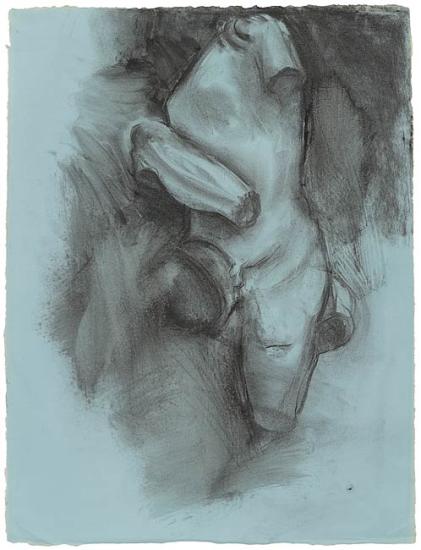
Seven Views of the Hermaphrodite [3]
In 1990 Dine traveled to the Ny Carlsberg Glyptotek in Copenhagen, where he spent seven days in the galleries to create this seven-part work, based on a statue of a hermaphrodite.
To highlight the subject's dual sexuality, antique sculptures of hermaphrodites typically display the figure in a complex, twisting pose. In each drawing, Dine depicted the figure from a different viewpoint. The sequence invokes the movement of the turning figure and its ability to define the space around it.
© 2011 Jim Dine / Artists Rights Society (ARS), New York
Seven Views of the Hermaphrodite [4]

Seven Views of the Hermaphrodite [4]
In 1990 Dine traveled to the Ny Carlsberg Glyptotek in Copenhagen, where he spent seven days in the galleries to create this seven-part work, based on a statue of a hermaphrodite.
To highlight the subject's dual sexuality, antique sculptures of hermaphrodites typically display the figure in a complex, twisting pose. In each drawing, Dine depicted the figure from a different viewpoint. The sequence invokes the movement of the turning figure and its ability to define the space around it.
© 2011 Jim Dine / Artists Rights Society (ARS), New York
Seven Views of the Hermaphrodite [5]
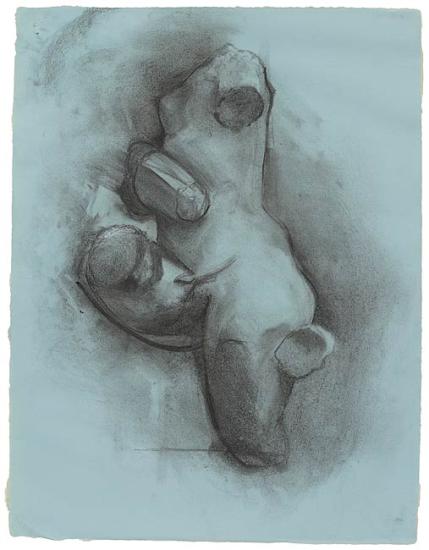
Seven Views of the Hermaphrodite [5]
In 1990 Dine traveled to the Ny Carlsberg Glyptotek in Copenhagen, where he spent seven days in the galleries to create this seven-part work, based on a statue of a hermaphrodite.
To highlight the subject's dual sexuality, antique sculptures of hermaphrodites typically display the figure in a complex, twisting pose. In each drawing, Dine depicted the figure from a different viewpoint. The sequence invokes the movement of the turning figure and its ability to define the space around it.
© 2011 Jim Dine / Artists Rights Society (ARS), New York
Seven Views of the Hermaphrodite [6]

Seven Views of the Hermaphrodite [6]
In 1990 Dine traveled to the Ny Carlsberg Glyptotek in Copenhagen, where he spent seven days in the galleries to create this seven-part work, based on a statue of a hermaphrodite.
To highlight the subject's dual sexuality, antique sculptures of hermaphrodites typically display the figure in a complex, twisting pose. In each drawing, Dine depicted the figure from a different viewpoint. The sequence invokes the movement of the turning figure and its ability to define the space around it.
© 2011 Jim Dine / Artists Rights Society (ARS), New York
Seven Views of the Hermaphrodite [7]
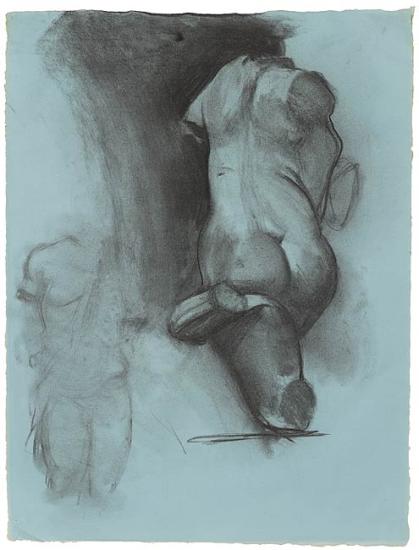
Seven Views of the Hermaphrodite [7]
In 1990 Dine traveled to the Ny Carlsberg Glyptotek in Copenhagen, where he spent seven days in the galleries to create this seven-part work, based on a statue of a hermaphrodite.
To highlight the subject's dual sexuality, antique sculptures of hermaphrodites typically display the figure in a complex, twisting pose. In each drawing, Dine depicted the figure from a different viewpoint. The sequence invokes the movement of the turning figure and its ability to define the space around it.
© 2011 Jim Dine / Artists Rights Society (ARS), New York
Twisted Torso of a Youth
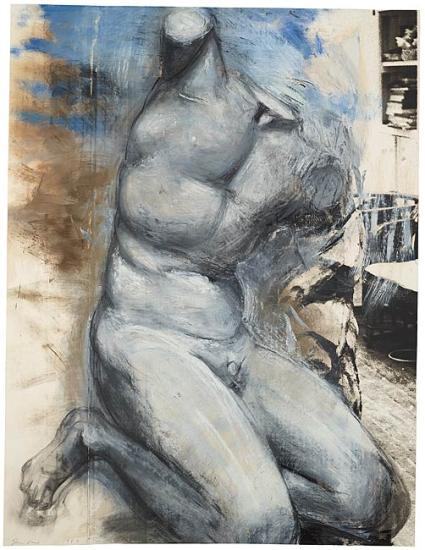
Twisted Torso of a Youth
1989
Dine made this drawing of an antique sculpture from the Munich Glyptothek in his London studio. He drew the figure of the twisted youth onto a screen print he had made from a photograph that his wife had taken of the studio. The sheet combines multiple layers of Dine's creative engagement with the antique: his studio photograph beneath the drawing shows the artist at work on a life-sized sculpture of Venus.
© 2011 Jim Dine / Artists Rights Society (ARS), New York
Three Roman Heads [1]

Three Roman Heads [1]
1991
These three drawings, made from photographs of sculptures from the Ny Carlsberg Glyptotek in Copenhagen, demonstrate the artist's physical approach to draftsmanship. Using large sheets of thick handmade paper, he applied his media in a highly gestural manner. Vigorously reworking each image, Dine exploited the expressive effects of accumulation, abrasion, and erasure.
© 2011 Jim Dine / Artists Rights Society (ARS), New York
Three Roman Heads [2]
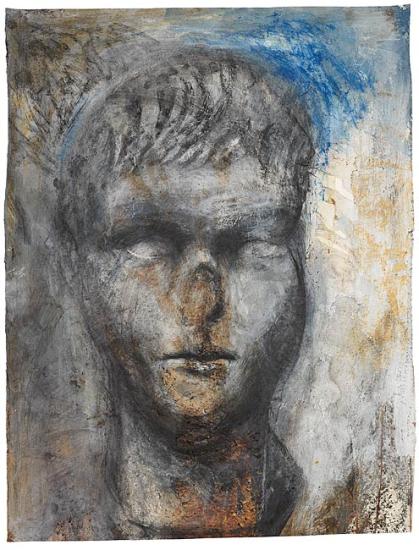
Three Roman Heads [2]
1991
These three drawings, made from photographs of sculptures from the Ny Carlsberg Glyptotek in Copenhagen, demonstrate the artist's physical approach to draftsmanship. Using large sheets of thick handmade paper, he applied his media in a highly gestural manner. Vigorously reworking each image, Dine exploited the expressive effects of accumulation, abrasion, and erasure.
© 2011 Jim Dine / Artists Rights Society (ARS), New York
Three Roman Heads [3]
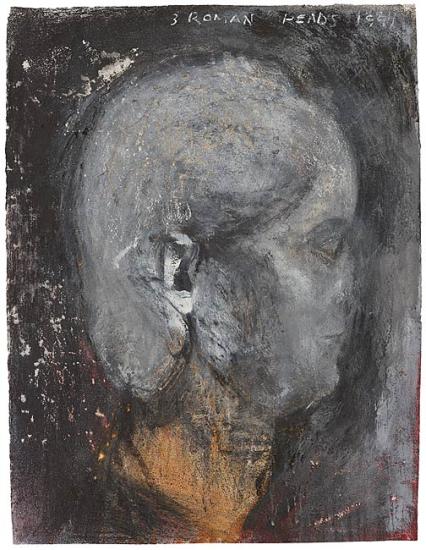
Three Roman Heads [3]
1991
These three drawings, made from photographs of sculptures from the Ny Carlsberg Glyptotek in Copenhagen, demonstrate the artist's physical approach to draftsmanship. Using large sheets of thick handmade paper, he applied his media in a highly gestural manner. Vigorously reworking each image, Dine exploited the expressive effects of accumulation, abrasion, and erasure.
© 2011 Jim Dine / Artists Rights Society (ARS), New York
